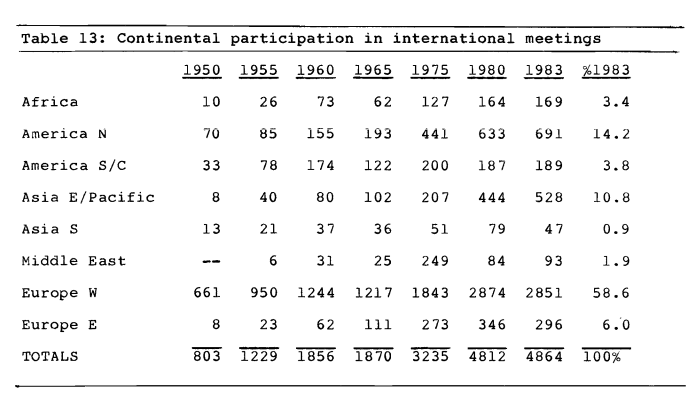CONTINENTAL OVERVIEW OF AFRICAN INVOLVEMENT IN INTERNATIONAL ORGANIZATIONS
In Part I the focus is on the African continent as a whole. No attempt is made to focus on individual countries or cities. It includes the following sections:
1.1 Number of African international organizations
For the purpose of this report "African international organizations" have been distinguished according to the criteria of the sections of the Yearbook of International Organizations. These sections are described above. Sections C to G, plus J, are relevant for this discussion.
Table 1 summarizes the information on the number of the African bodies from these sections.
Note that it does not include information on non-African international bodies-with offices in Africa. (This information is discussed in later sections.) It does however include African bodies headquartered outside Africa. These may include, for example, Afro-Asian bodies (section C) or national institutes of African studies in other countries (section G).
The information in Table 1 may be compared with the world totals in Table 2, which covers all international organizations listed in the Yearbook of International Organizations. Details by country are given in Table 14. Intergovernmental organizations are listed in Annex 1.
As is to be expected in developing countries, the percentage of intergovernmental bodies is much higher for Africa than for the world as a whole.
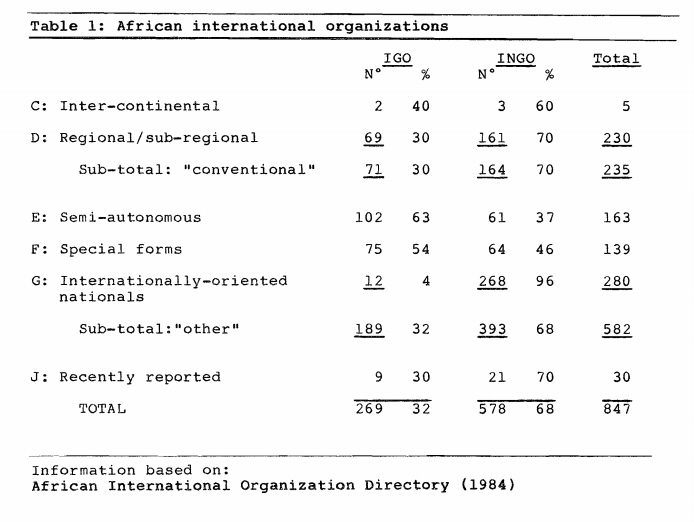
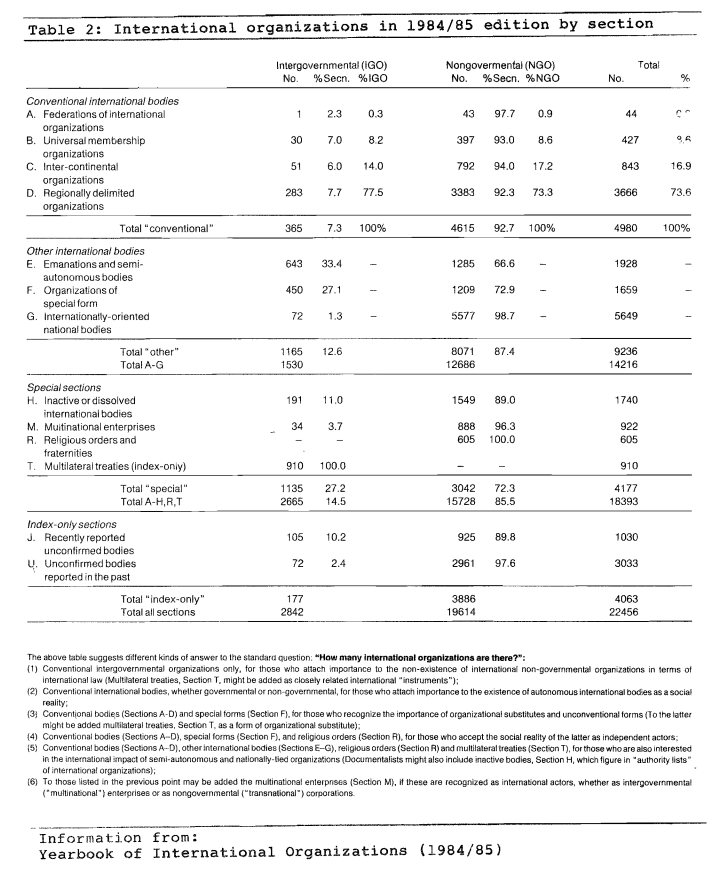
1.2 Number of African organization secretariats
The information in Table 1 disguises the extent to which "African international organizations" may be based in non-African countries (for example, the African and Malagasy Coffee Organization based in Paris). This has been clarified in Table 3 which shows the location of the secretariats of the organizations identified in Table 1. Details by country are given in Table 14, and by city in Table 21.
Note that since a significant number of bodies either do not have addresses or have no current or traceable address, the totals for Table 3 are lower than for Table 1.
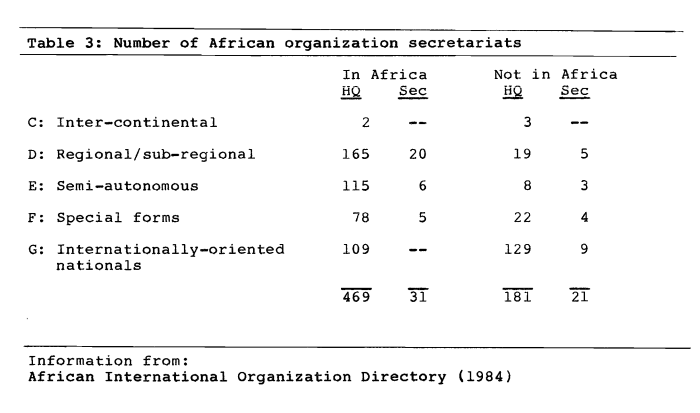
1.3 Number of Africa-based international organizations
In addition to the African organizations described in the previous section, non-African bodies may have secretariats located in Africa.~hese may include organizations distinguished by criteria of the Yearbook of International Organizations in addition to those noted above:
Table 4 summarizes the information on all Africa-based organizations, together with comparative figures for other continents. Details by country are given in Table 15, and by city in Table 22.
Note that a distinction is made in each case between:
- Principal office/Headquarters
- Secondary office/Sub-regional office
In the event that one organization has both types in Africa, the Table records both.
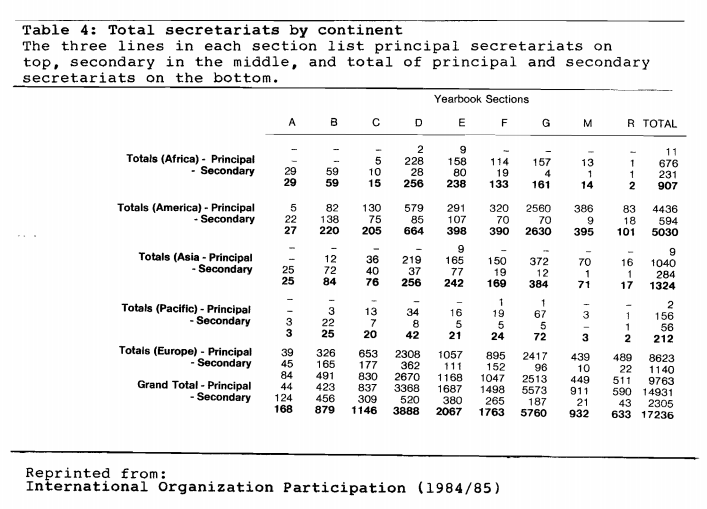
The figures in Table 4 may be compared with similar figures for earlier years as shown in Table 5. Note that the data in this table covers organizations of types A, B, C, and D. It does not include the "non-conventional" types covered in Table 4 (e.g. E, F, G, M, and R).
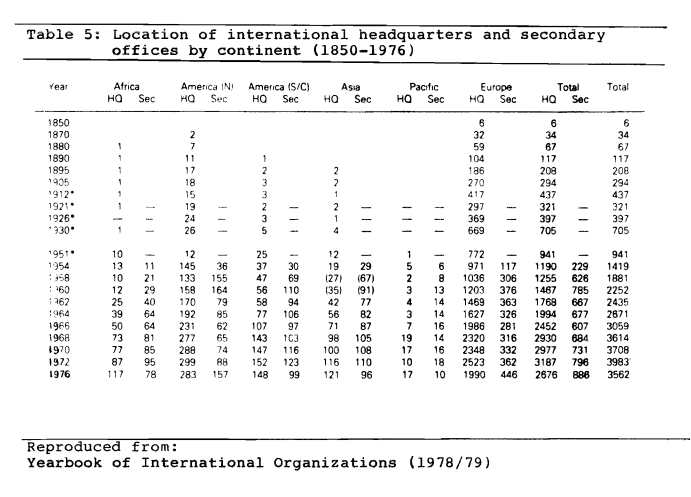
1.4 Number of organizations with African membership
To complete the overall picture, the number of organizations with African country membership is given in Table 6. A distinction is made between African organizations and organizations with memberships from other continents, in various combinations (e.g. Afro-Asia, Euro-Africa, etc.). Table 6 is derived from International Organization Participation (Volume 2 of the Yearbook of International Organizations 1984/85).
Table 6 also covers two additional sections from the Yearbook:
Table 6 may be usefully compared with Table 7, based on an equivalent analysis in 1977. Note that Table 7 only covers organizations of types A, B, C, and D.
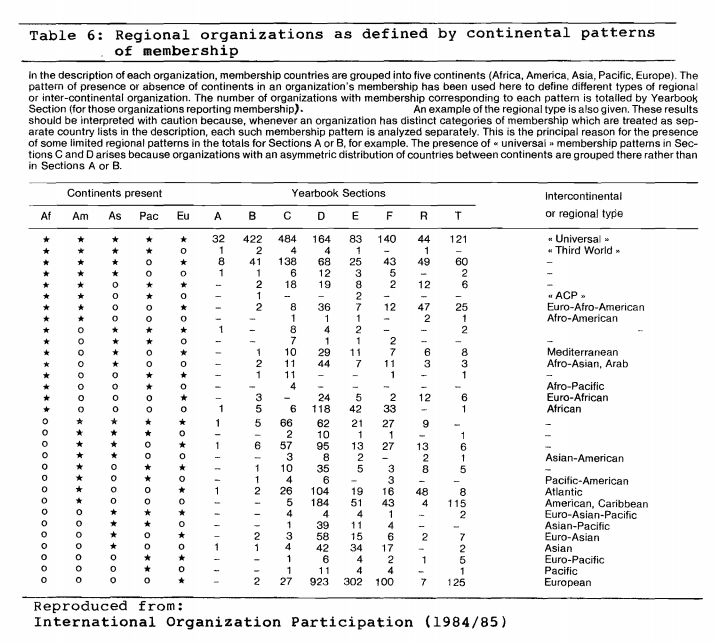
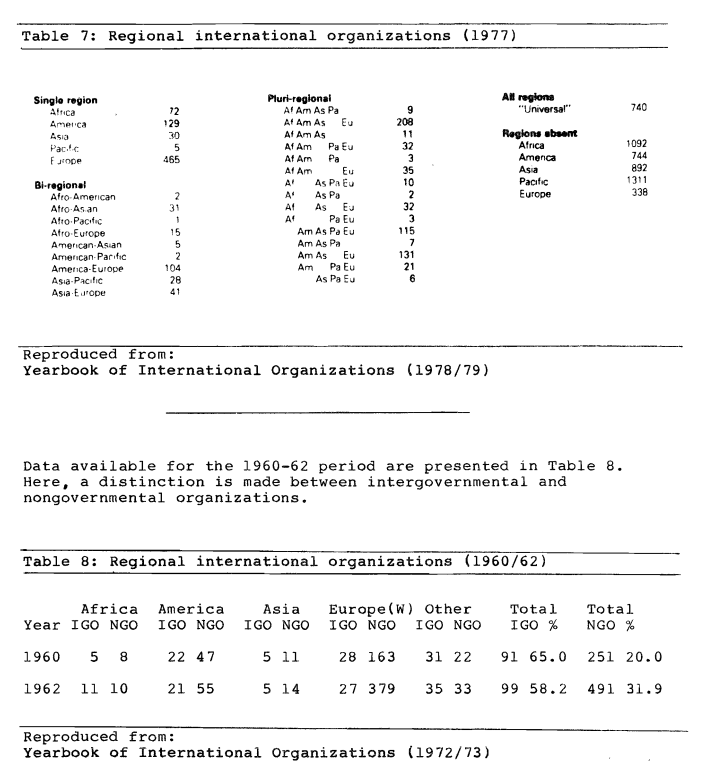
1.5 African participation in international orqanization
Data on the participation of African countries in all international organizations may now be presented, as compared with the participation from other continents in international organizations.
This data is presented in Table 9. It is based on the African countries which are members of international organizations or in which (one or more) members of international organizations are located. Details by country are given in Table 17.
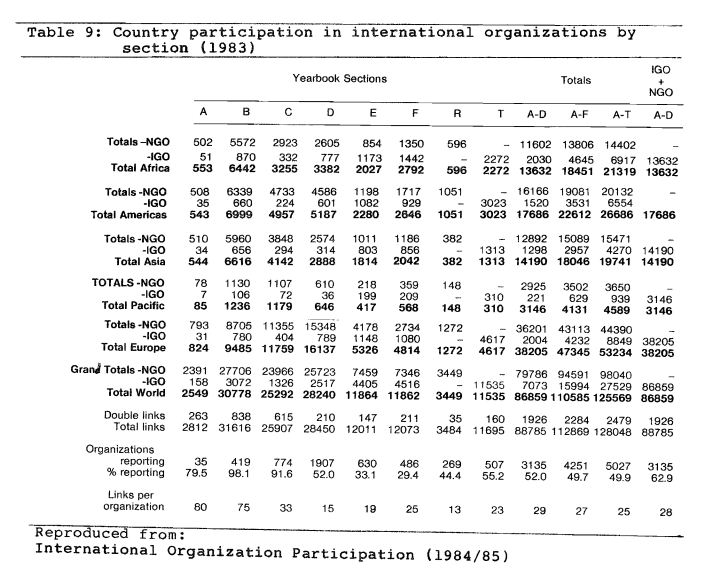
The data in Table 9 may be compared with that in Table 10 which shows the evolution of this participation from 1960. The figures in Table 10 are for types A, B, C, and D and do not include the other types covered by Table 9. Details by country for Table 10 are given in Table 19.
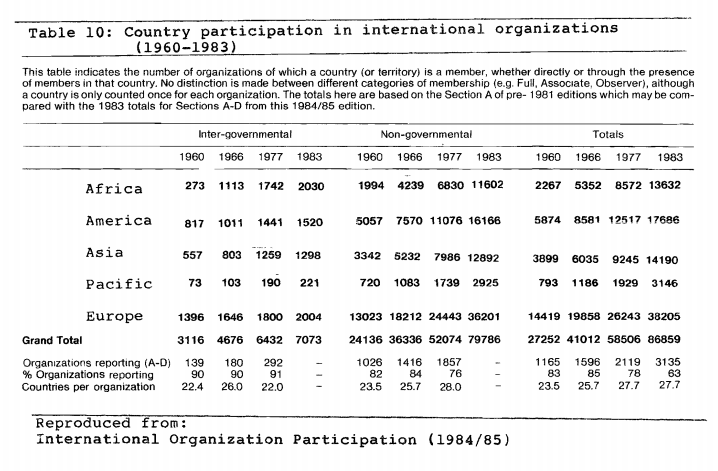
1.6 Overview of African participation in international organizations by sub-region
In order to provide another basis for interpreting the data in the previous tables, the information has been analyzed into somewhat arbitrary sub-regions. Most African countries are in the regions that would be expected. Borderline cases have been allocated as follows:
An (F) or and (E) following the name of the sub-region indicates French-speaking and English-speaking respectively.
The first line against each sub-region indicates the number of secretariats located there, while the second line indicates the number of countries of that region having membership, either directly or indirectly, in international organizations.
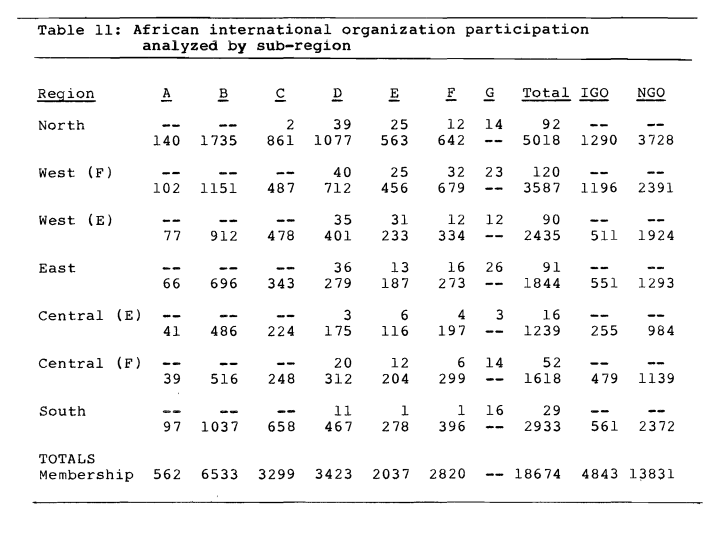
1.7 Chronological summary of establishment of African organizations
In Table 12 is presented by year, according to the Yearbook sections noted above, the dates of foundation (when available) of African international organizations. The Table does not include data on those which have ceased to exist (unless they have not yet been transferred out of the sections under which they were listed). Details by organization are given in Annexes 2 and 3.
The Table lists for each year an upper line indicating intergovernmental organizations, indicating nongovernmental organizations.
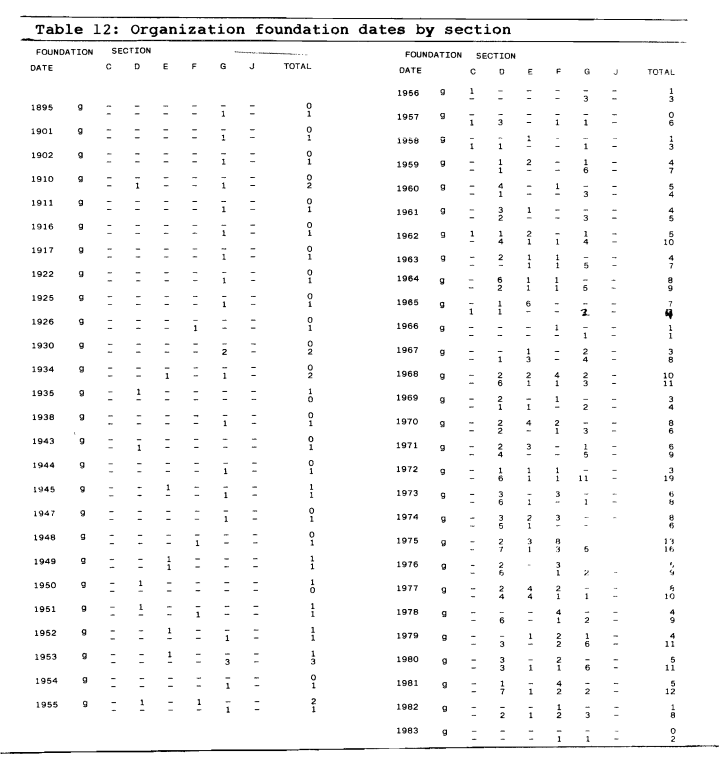
1.8 International meetings held in Africa
The data presented in Table 13 is based on information reported in the International Congress Calendar. It therefore includes meetings organized by international organizations, whether African or not, as well as international meetings organized by other bodies. Comparative figures are given for the period 1950 to 1983. (No African country data is grouped under "Middle East".)
Details for individual African countries are given in Table 20. A listing of African organizations only by meeting year is given in Annex 6.
